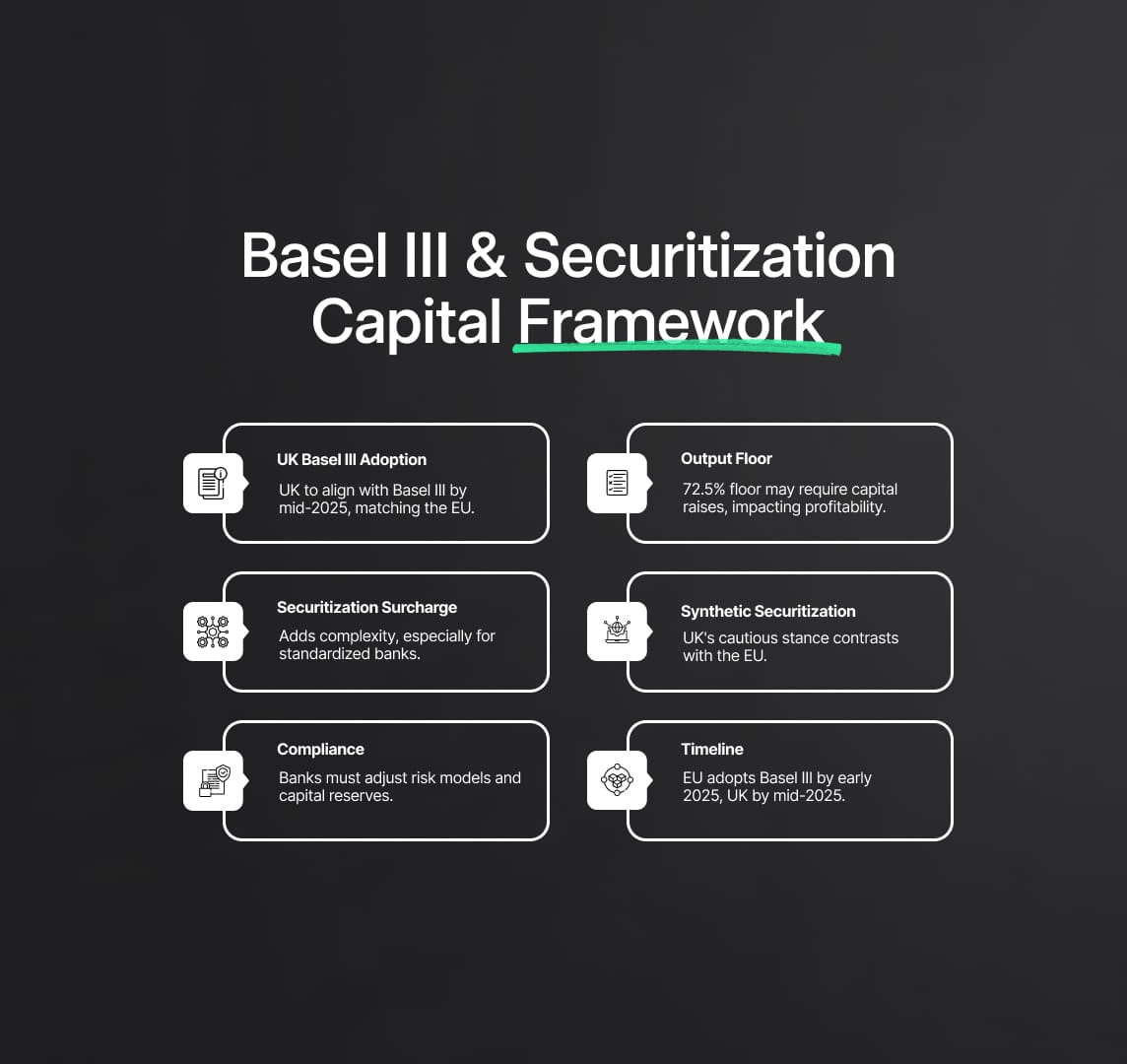Basel III Implementation: EU and UK Diverge
The UK's strategic adoption of Basel III regulation, led by the Bank of England, is set for mid-2025, following the EU's early 2025 implementation. Key focus areas include the output floor, securitization capital surcharge, and synthetic securitizations under the STS framework.

Basel III Implementation and Securitisation Capital Framework
The recent discussion paper released by the Bank of England, which centers on the Basel III framework, represents a noteworthy advancement in the development of banking rules, specifically with securitization capital needs. This document becomes more pertinent as the financial industry prepares for the EU's CRR3 (Regulation EU No 575/2013) to go into effect on January 1, 2025, with the UK adopting it six months later. It offers insights into the future of banking rules by addressing important aspects of the Basel III recommendations.
Three crucial Basel III framework areas are the focus of the discussion paper. First, it looks at the output floor's whole implementation. This is an important feature since it establishes a threshold, meaning that the risk-weighted assets that banks compute using their proprietary models must equal or exceed 72.5% of the assets computed using a standard method. The purpose of this approach is to ensure that banks operate on an even playing field and to avoid underestimating risk.
The second topic covered in the study is the securitization-related additional capital charge. In order to mitigate the risks related to modeling and agency in securitization transactions, this surcharge has been implemented. The Basel III framework intends to increase the financial system's resistance to possible errors in estimation and deception in securitization procedures by enforcing this surcharge.
Thirdly, there is disagreement about how synthetic securitizations should be handled under the STS (Simple, Transparent, and Standardized) paradigm. The study raises the question of whether it should be included under the STS moniker, which is generally applied to securitization systems that are simpler and more transparent. In order to maintain uniformity and transparency in the securitization market, this factor is essential.
The Bank of England is strategically including important stakeholders in the Prudential Regulation Authority's rule-making process by requesting input from industry players. This cooperative approach not only makes the new legislation more relevant and effective, but it also fits in with the worldwide movement toward stronger and more transparent banking operations, which is supported by the Basel III standards.

Basel III Regulation: The UK's Strategic Approach
The Bank of England's drive to enact the Basel III rule in the United Kingdom represents a significant shift in the country's approach to financial regulation. This tactical decision is in line with the wider global banking community, especially because it coincides with the EU's implementation of CRR3 (Regulation EU No 575/2013).
By adopting these measures by mid-2025, the UK is showing its commitment to global financial stability and the adoption of strict, globally recognized banking standards. This timeframe closely follows the EU's implementation of these rules in early 2025. This alignment is a strategic move to guarantee that the UK's banking industry stays strong, competitive, and equipped to handle the demands of an increasingly interconnected global financial system, in addition to being a regulatory compliance requirement.
Basel III Regulation and the Output Floor Challenge
The introduction of the output floor in the Basel III regulation is a significant development in the world of banking risk management:
- Risk Assessment and Fairness: A minimum threshold of 72.5% is introduced for risk-weighted assets under the Basel III framework. This guideline is intended to guarantee that all banks follow a minimal degree of risk coverage, irrespective of their size or worldwide reach. In an effort to level the playing field, it forbids big banks from unduly relying on their proprietary models in order to reduce capital needs.
- Implications for Capital Holdings: The new rule will require banks with assets now valued below this threshold to raise their capital holdings. Their investment and operational strategies may significantly change as a result of this necessity. Although this guarantees a safer financial environment, it also makes it more difficult for banks to remain profitable and competitive, particularly for those that have historically made riskier bets.

The Impact of Securitization Capital Surcharge under Basel III
The Basel III regulation's introduction of a securitisation capital surcharge is a critical element in enhancing the safety and soundness of banking practices:
- Reducing Inherent Risks: The purpose of this surcharge is to reduce the risks that come with securitization procedures, especially those that result from intricate modeling and agency problems. Basel III aims to reduce the systemic risks that were brought to light after the 2008 financial crisis by enforcing higher capital requirements for securitization exposures.
- Regulatory Complexity and Recalibration: Banks face a challenging situation in the event that this surcharge is recalibrated. On the one hand, it might result in a regulatory framework that is more proportionate and balanced. However, it also adds a level of complexity and could make regulations more onerous, especially for institutions that mostly employ the standardized approach. To balance risk reduction with operational viability will be a difficulty for both regulators and institutions.
Basel III Regulation and Synthetic Securitizations
The treatment of synthetic securitizations under Basel III is a topic of considerable debate and significance:
- The STS Framework Issue: It is controversial to use the STS (Simple, Transparent, and Standardized) name to synthetic securitizations. The Bank of England's cautious approach in this case is a reflection of its worries about the possible dangers and complexity of these instruments. One reason for the reluctance to expand the STS label could be the desire to keep these more complicated financial products under strict supervision and with risk managed appropriately.
- Potential for Regulatory Divergence: If this strategy is adopted, there could be differences in regulations between the EU and the UK, with the UK adopting a more conservative position. The competitive environment may be significantly impacted by this discrepancy since it could have an impact on the viability and appeal of synthetic securitizations in the UK market.
Navigating the Basel III Landscape: Strategies for Compliance
As the Basel III regulation comes into effect, banks and financial institutions are required to undertake comprehensive strategies for compliance:
- Improving Internal Risk Models: Aligning internal risk assessment models with Basel III criteria is one of the primary compliance solutions. The way banks compute risk-weighted assets and handle their capital requirements may need to change significantly as a result of this realignment.
- Capital Reserves Adjustment: Adjustment to Capital Reserves: The new regulations, in particular the output floor and the capital surcharge for securitization, will probably require modifications to capital reserves. To comply with the stricter regulations, banks could have to raise their capital buffers, which might have an effect on their overall financial plans and capacity for making investments.
Looking Ahead: Basel III Implementation Timeline
The timeline for the implementation of Basel III regulation is critical for the planning and preparation by banks:
- EU Implementation: Set for early 2025, this will set the stage for subsequent adoption in other jurisdictions, including the UK.
- UK Adoption: Slated for mid-2025, allowing UK banks a brief window to observe and learn from the EU implementation.
- Feedback and Finalization: Ongoing feedback from industry stakeholders will be instrumental in refining the final aspects of the Basel III regulations, ensuring they are well-tailored to the UK banking sector's needs.
Read More
Reduce your
compliance risks


